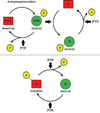Protein tyrosine phosphatases--from housekeeping enzymes to master regulators of signal transduction
- PMID: 23176256
- PMCID: PMC3662559
- DOI: 10.1111/febs.12077
Protein tyrosine phosphatases--from housekeeping enzymes to master regulators of signal transduction
Abstract
There are many misconceptions surrounding the roles of protein phosphatases in the regulation of signal transduction, perhaps the most damaging of which is the erroneous view that these enzymes exert their effects merely as constitutively active housekeeping enzymes. On the contrary, the phosphatases are critical, specific regulators of signalling in their own right and serve an essential function, in a coordinated manner with the kinases, to determine the response to a physiological stimulus. This review is a personal perspective on the development of our understanding of the protein tyrosine phosphatase family of enzymes. I have discussed various aspects of the structure, regulation and function of the protein tyrosine phosphatase family, which I hope will illustrate the fundamental importance of these enzymes in the control of signal transduction.
© 2012 The Author Journal compilation © 2012 FEBS.
Figures









References
-
- Tonks NK, Diltz CD, Fischer EH. Purification of the major protein tyrosine phosphatases of human placenta. J Biol Chem. 1988;263:6722–6730. - PubMed
-
- Tonks NK, Diltz CD, Fischer EH. Characterization of the major protein tyrosine phosphatases of human placenta. J Biol Chem. 1988;263:6731–6737. - PubMed
-
- Brautigan DL. Protein Ser/ Thr phosphatases - the ugly ducklings of cell signalling. Febs J. 2012 - PubMed
-
- Krebs EG. Protein phosphorylation and cellular regulation I. Nobel Lecture. 1992:72–89. - PubMed
-
- Fischer EH. Protein phosphorylation and cellular regulation II. Nobel Lecture. 1992:95–113.
Publication types
MeSH terms
Substances
Grants and funding
LinkOut - more resources
Full Text Sources
Other Literature Sources
Molecular Biology Databases
Miscellaneous

